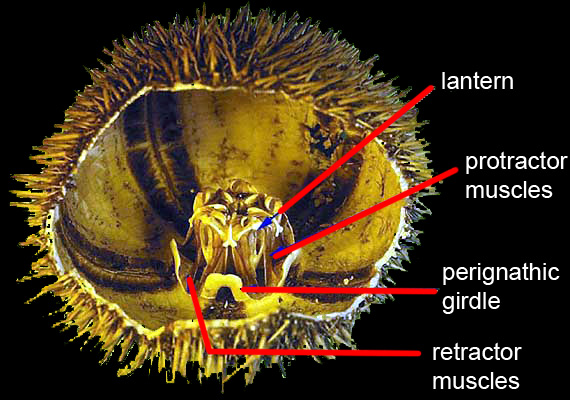Glossary
Glossary terms beginning with: A
show all images
- aboral
-
the side or direction away from the mouth. Also referred to as adapical
(show image)
- accessory pores
-
Microscopic isopores (B) (less than 100 microns) found in Clypeasteroida often forming dense fields (A, C). Each connects a tube-foot to the interior of the test.
(show image)
- acetabulum
-
The basal surface of a spine that rests directly on its associated tubercle.
(show image)
- acrosaleniid plate compounding
-
A compound ambulacral plate composed of three elements of which only two are united by an overlying tubercle: the third element is simple. This is also known as a semicompound plate.
(show image)
- adapical
-
at or towards the apical disc (direction). Also known as aboral.
(show image)
- adradial
-
at or towards the boundary betwseen ambulacral and interambulacral zones (direction)
(show image)
- adradius
-
The line separating ambulacral and interambulacral columns of plates.
(show image)
- ambital
-
At or towards the ambitus
(show image)
- ambitus
-
The point of widest circumference on the test
(show image)
- ambulacra
-
pleural of ambulacrum
(show image)
- ambulacrum (-a)
-
The zone of plates associated with the water vascular system and tube-feet and usually biserially arranged. There are five ambulacral zones in the corona of extant echinoids.
(show image)
- amphiplacous
-
An interambulacrum in which the first (primordial) plate (red) is in contact with the succeeding plates (purple) from both columns.
(show image)
- amphisternous
-
Referring to echinoids with an amphiplacous plastron.
(show image)
- ampulla
-
Internal bulbose or leaf-shaped organ that is part of the water vascular system and directly underlies tube-feet. It acts as a fluid resevoir for expansion and constraction of the associated tube-foot.
(show image)
- anal (fasciole)
-
A fasciole band that runs vertically from the subanal fasciole passing on either side of the periproct (ppt).
(show image)
- anal lunule
-
A lunule that pierces interambulacrum 5 and which, on the adoral face, is closely associated with the periproct.
(show image)
- anal sulcus
-
A groove on the aboral surface running towards the posterior of the test from the periproct.
(show image)
- anal tuft
-
A single or double cone of spines that projects from the rear of the test beneath the anus. These spines are used in constructing the subanal funnel and are surrounded by a subanal fasciole.
(show image)
- anisopore
-
The connection between tube-foot and internal water vessel where there are a pair of pores of markedly unequal size.
(show image)
- apical
-
at or towards the apical disc (direction)
(show image)
- apical disc
-
The small area of plates forming the aboral surface of the test at the apex of the ambulacral and interambulacral zones. Composed of ocular and genital plates, which (in regulars) surround the periproct.
(show image)
- apophysis
-
Interambulacral element of the perignathic girdle. An internal flange (ap) that originates from the most adoral interambulacral plates. Lantern protractor muscles attach to these. [Picture shows the interior of the oral region.]
(show image)
- arbaciid plate compounding
-
A compound ambulacral plate composed of three (rarely four) elements of which the middle is always the largest. Upper and lower elements are always small and do not reach the perradius.
(show image)
- areole
-
A flat platform of fine stereom surrounding the boss and marking the attachment site of spine muscle on a tubercle. Can be depressed in cidaroids
(show image)
- Aristotle's lantern
-
The complex jaw apparatus found in regular echinoids.

- auricle
-
Ambulacral element of the perignathic girdle. An internal flange (au) originating from the most adoral ambulacral plates. Lantern retractor muscles attach to these. [Picture shows the interior of the oral region.]
(show image)
|